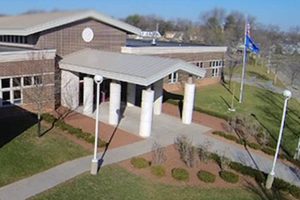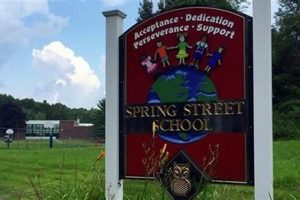A primary educational institution typically serves students from kindergarten through fifth or sixth grade. This type of institution provides foundational education in core subjects such as reading, writing, mathematics, science, and social studies. It also fosters social and emotional development in a structured environment. For example, such an institution might offer extracurricular activities like art, music, and physical education.
These institutions play a vital role in child development, providing a nurturing environment for academic and personal growth. Early education sets the stage for future learning, developing critical thinking skills and a love of knowledge. Historically, these institutions have evolved alongside societal needs, adapting curricula and teaching methods to meet the changing demands of the times. Their continued importance lies in their ability to shape future generations and contribute to a well-informed citizenry.
This foundation provides a springboard for exploring specific topics related to primary education, such as curriculum development, teacher training, educational policy, and the impact of community involvement. Further examination of these areas can offer a deeper understanding of the complexities and challenges facing primary education today.
Tips for Educational Success in Early Elementary
Successfully navigating the early years of elementary education requires a multifaceted approach involving families, educators, and the wider community. These tips offer guidance to support students in reaching their full potential.
Tip 1: Foster a Love of Reading: Regular reading at home, even for short periods, cultivates literacy skills and a positive association with books. Trips to the local library and engaging with diverse literary materials can further enhance this process.
Tip 2: Encourage Curiosity: Answering questions patiently and fostering exploration helps children develop critical thinking skills. Creating opportunities for hands-on learning through science experiments or nature walks can stimulate inquisitiveness.
Tip 3: Establish Consistent Routines: Predictable schedules for homework, bedtime, and meals provide structure and support academic performance. Consistent routines reduce stress and promote healthy habits.
Tip 4: Maintain Open Communication with Educators: Regularly communicating with teachers allows parents to stay informed about their child’s progress and address any concerns promptly. Parent-teacher conferences provide valuable opportunities for collaboration.
Tip 5: Support Social and Emotional Development: Encouraging positive interactions with peers and teaching conflict resolution skills contributes to a child’s social-emotional well-being. Creating opportunities for teamwork and collaboration can foster empathy and cooperation.
Tip 6: Create a Supportive Learning Environment at Home: Designating a quiet space for homework and providing necessary resources, such as pencils and paper, can significantly impact a child’s ability to focus and succeed academically. Minimizing distractions during study time is crucial.
Tip 7: Emphasize the Importance of a Healthy Lifestyle: Ensuring adequate sleep, nutritious meals, and regular physical activity supports both physical and cognitive development. Healthy habits established early in life contribute to long-term well-being.
By implementing these strategies, families and educators can contribute to a supportive and enriching educational experience for young learners. These practices empower children to develop essential skills and thrive academically and personally.
This guidance provides a starting point for creating a strong foundation for educational success in the crucial early elementary years. Further exploration of these topics can offer a more comprehensive understanding of best practices in primary education.
1. Curriculum
The curriculum at an elementary school like Pike Elementary forms the core of the educational experience, directly impacting student learning outcomes. A well-designed curriculum provides a structured framework for instruction, ensuring alignment with educational standards and preparing students for future academic pursuits. The curriculum’s effectiveness hinges on several factors, including its alignment with student needs and developmental stages, the incorporation of engaging and diverse learning materials, and its adaptability to different learning styles. For example, a robust mathematics curriculum might incorporate hands-on activities, problem-solving exercises, and real-world applications to enhance understanding and foster critical thinking skills. Similarly, a comprehensive literacy curriculum would encompass phonics, reading comprehension, writing, and communication skills, providing a solid foundation for future academic success.
The choice of curriculum significantly influences the educational trajectory of students at Pike Elementary. A curriculum emphasizing STEM subjects (Science, Technology, Engineering, and Mathematics) could cultivate interest in these fields, potentially leading to future career paths in related disciplines. Alternatively, a curriculum rich in arts and humanities could foster creativity, critical thinking, and cultural awareness. Furthermore, a well-rounded curriculum should address social-emotional learning, promoting positive character development and preparing students to navigate social interactions effectively. The intentional selection and implementation of a specific curriculum demonstrates the institution’s educational philosophy and priorities. Choosing a project-based learning curriculum, for example, reflects a commitment to active learning and student-centered education.
Understanding the curriculum at Pike Elementary provides valuable insights into the institution’s educational goals and its approach to student development. Analyzing the curriculums structure, content, and assessment methods offers a comprehensive understanding of the educational experience provided to students. Challenges in curriculum implementation, such as limited resources or professional development needs, can impact the effectiveness of even the most thoughtfully designed curriculum. Addressing these challenges requires ongoing evaluation, adaptation, and collaboration among educators, administrators, and the wider community. Ultimately, a strong curriculum, effectively implemented, contributes significantly to the success of students at Pike Elementary and their preparation for future academic endeavors.
2. Faculty Expertise
Faculty expertise significantly influences the educational quality within an elementary school setting. The educators’ knowledge, skills, and experience directly impact students’ learning outcomes and overall development. Examining faculty expertise requires considering various facets that contribute to effective teaching and learning.
- Subject Matter Proficiency
A deep understanding of the subjects taught is fundamental to effective instruction. Teachers proficient in their subject matter can convey information accurately, address student questions comprehensively, and foster a deeper understanding of concepts. For instance, a mathematics teacher with a strong mathematical background can explain complex concepts clearly, provide relevant examples, and differentiate instruction to meet diverse learning needs. This expertise translates directly into students’ ability to grasp mathematical principles and apply them effectively.
- Pedagogical Knowledge
Effective teaching extends beyond subject matter expertise. Pedagogical knowledge, encompassing various teaching strategies and methodologies, is crucial for creating engaging and effective learning experiences. A teacher skilled in differentiated instruction can adapt their teaching methods to cater to diverse learning styles and needs within the classroom. Utilizing various instructional techniques, such as project-based learning or inquiry-based learning, can further enhance student engagement and foster critical thinking skills.
- Classroom Management Skills
Creating a positive and productive learning environment requires effective classroom management. Teachers skilled in classroom management can establish clear expectations, address disruptive behaviors effectively, and foster a sense of respect and cooperation among students. A well-managed classroom minimizes distractions, maximizing learning time and allowing students to focus on their studies. This contributes to a positive learning experience for all students.
- Professional Development and Continuous Learning
The field of education is constantly evolving. Effective teachers engage in ongoing professional development to stay abreast of current research, best practices, and new pedagogical approaches. Participating in workshops, conferences, and collaborative learning communities allows teachers to refine their skills, expand their knowledge base, and implement innovative teaching strategies. This commitment to continuous learning ensures that students benefit from the most current and effective educational practices.
These facets of faculty expertise collectively contribute to a high-quality learning environment within an elementary school. A school like Pike Elementary, with a faculty possessing strong subject matter knowledge, pedagogical skills, classroom management abilities, and a commitment to ongoing professional development, provides students with a solid foundation for academic success and personal growth. The impact of faculty expertise extends beyond individual student outcomes, influencing the overall school culture and contributing to the institution’s reputation for educational excellence.
3. Community Engagement
Community engagement plays a vital role in the success of an elementary school like Pike Elementary. A strong connection between the school and its surrounding community creates a supportive and enriching learning environment. This engagement manifests in various forms, each contributing to the overall educational experience. Parental involvement, for example, can range from volunteering in classrooms to participating in school governance. Local businesses might offer mentorship programs or donate resources to the school. Community organizations can provide extracurricular activities or support services for students and families. These collaborative efforts create a network of support that strengthens the school’s ability to meet the diverse needs of its students.
The effects of robust community engagement are multifaceted. Increased parental involvement correlates positively with improved student academic performance and behavior. When parents actively participate in their children’s education, students are more likely to succeed academically and develop positive attitudes towards learning. Partnerships with local businesses and organizations provide students with valuable real-world experiences, expanding their horizons and preparing them for future career paths. Furthermore, community engagement fosters a sense of belonging and shared responsibility for the school’s success. This collective effort creates a positive school culture, benefiting students, teachers, and the wider community. For instance, a local library partnering with Pike Elementary to offer after-school reading programs can enhance literacy skills and foster a love of reading among students. Similarly, a local business sponsoring a science fair can spark students’ interest in STEM fields and provide valuable mentorship opportunities.
Cultivating strong community engagement requires ongoing effort and a commitment to collaboration. Schools must actively seek opportunities to connect with families, businesses, and community organizations. Establishing clear communication channels, organizing community events, and creating opportunities for meaningful participation are essential for building strong relationships. Challenges such as socioeconomic disparities or language barriers can hinder community engagement, requiring targeted strategies to ensure equitable access and participation. Overcoming these challenges requires a commitment to inclusivity and culturally responsive practices. Ultimately, robust community engagement serves as a cornerstone of a thriving elementary school, enriching the educational experience for all stakeholders and contributing to the overall well-being of the community.
4. Resource Availability
Resource availability significantly impacts the educational experience at any elementary school, including Pike Elementary. Adequate resources are essential for providing a high-quality education that meets the diverse needs of students. This encompasses a range of resources, from essential learning materials and technology to qualified staff and supportive services. The availability of these resources directly influences the school’s ability to implement effective instructional programs, support student learning, and create a positive learning environment.
- Learning Materials and Technology
Access to up-to-date textbooks, educational software, and other learning materials is crucial for effective instruction. Modern technology, including computers, interactive whiteboards, and online learning platforms, can enhance learning experiences and prepare students for a technology-driven world. For example, access to digital literacy tools can enhance reading and writing skills, while science labs equipped with the necessary materials can provide hands-on learning experiences. Insufficient learning materials or outdated technology can hinder student progress and limit educational opportunities.
- Qualified Staff and Support Services
A well-resourced school has a sufficient number of qualified teachers, support staff, and specialized personnel to meet student needs. This includes teachers with expertise in specific subject areas, counselors to address students’ social-emotional well-being, and special education staff to support students with learning disabilities. Adequate staffing ensures that students receive individualized attention and support, promoting academic success and overall well-being. A shortage of qualified staff can strain existing resources, limiting the school’s ability to provide effective instruction and support services.
- Facilities and Infrastructure
The physical environment plays a crucial role in student learning. Well-maintained classrooms, libraries, and other learning spaces create a conducive learning environment. Access to facilities such as computer labs, art rooms, and music rooms enriches the educational experience and provides opportunities for students to explore their interests and talents. Inadequate facilities or outdated infrastructure can negatively impact student learning and create safety concerns.
- Funding and Budgetary Resources
Adequate funding is essential for providing necessary resources and supporting school operations. Sufficient budgetary resources allow schools to invest in high-quality learning materials, hire qualified staff, maintain facilities, and provide essential programs and services. Limited funding can constrain resource availability, impacting the quality of education and limiting opportunities for students. Resource allocation decisions reflect the school’s priorities and commitment to providing a well-rounded education.
The availability of these resources collectively shapes the educational experience at Pike Elementary. A well-resourced school can provide a richer and more effective learning environment, leading to improved student outcomes. Conversely, a lack of resources can create significant challenges, hindering student progress and limiting educational opportunities. Analyzing resource availability at Pike Elementary provides valuable insights into the school’s capacity to provide a high-quality education and support the success of all students. Furthermore, understanding resource allocation and potential disparities in resource distribution can inform advocacy efforts aimed at improving educational equity and ensuring that all students have access to the resources they need to thrive.
5. Student Support Services
Student support services form an integral component of a well-rounded education at an elementary school like Pike Elementary. These services address the diverse academic, social, emotional, and physical needs of students, contributing significantly to their overall well-being and academic success. A comprehensive support system recognizes that students learn and thrive best when their individual needs are met. This support can manifest in various forms, including academic interventions, counseling services, special education programs, and health and wellness initiatives. The specific services offered reflect the unique needs of the student population and the school’s commitment to providing holistic support. For example, a student struggling with reading might receive targeted interventions from a reading specialist, while a student experiencing emotional difficulties might benefit from counseling services provided by a school psychologist.
The impact of robust student support services extends beyond individual student well-being. When students feel supported and have access to resources that address their specific needs, they are more likely to engage in learning, develop positive relationships with peers and educators, and achieve academic success. Effective support services can also contribute to a positive school climate, reducing behavioral problems and fostering a sense of belonging. Furthermore, providing early interventions for students experiencing difficulties can prevent more significant challenges from arising later in their academic careers. For instance, early identification and support for students with learning disabilities can significantly improve their academic outcomes and overall well-being. Similarly, providing access to mental health services can help students cope with stress, anxiety, and other emotional challenges, promoting their social-emotional development and academic success.
Implementing and maintaining effective student support services requires ongoing assessment, collaboration, and resource allocation. Schools must regularly evaluate the effectiveness of existing programs and adapt services to meet the evolving needs of the student population. Collaboration among educators, support staff, families, and community organizations is crucial for creating a comprehensive and coordinated support system. Adequate funding and resource allocation are essential for ensuring that schools have the necessary personnel, materials, and programs to provide effective student support. Addressing challenges such as limited resources, staffing shortages, or increasing student needs requires creative problem-solving and a commitment to prioritizing student well-being. Ultimately, a strong student support system serves as a cornerstone of a successful elementary school, contributing significantly to student achievement, positive school climate, and the overall well-being of the school community. Understanding the importance of these services and advocating for their continued development are essential for ensuring that all students have the opportunity to thrive.
Frequently Asked Questions
This section addresses common inquiries regarding elementary school education, providing concise and informative responses.
Question 1: What are the typical age ranges for students in elementary school?
Elementary schools typically serve students aged five to eleven, encompassing kindergarten through fifth or sixth grade, depending on the specific school district.
Question 2: What is the role of standardized testing in elementary education?
Standardized tests assess student progress and evaluate school performance in relation to established educational standards. These tests provide data used to inform curriculum development, instructional strategies, and resource allocation.
Question 3: How can parents support their child’s academic success in elementary school?
Parental involvement plays a crucial role in student success. Regular communication with teachers, establishing consistent routines for homework and study, creating a supportive learning environment at home, and fostering a love of reading contribute significantly to a child’s academic progress.
Question 4: What are the key indicators of a high-quality elementary school?
Indicators of a high-quality elementary school include a rigorous and engaging curriculum, experienced and dedicated teachers, strong administrative leadership, a supportive and inclusive school culture, active parental and community involvement, and adequate resources to support student learning.
Question 5: What are the benefits of extracurricular activities in elementary school?
Extracurricular activities provide opportunities for students to explore their interests, develop social skills, and engage in physical activity. These activities can enhance creativity, teamwork, leadership skills, and overall well-being.
Question 6: How can schools address the diverse learning needs of students in elementary school?
Addressing diverse learning needs requires differentiated instruction, individualized support services, and a commitment to inclusive educational practices. This may involve providing specialized instruction for students with learning disabilities, offering advanced learning opportunities for gifted students, and adapting curriculum and instruction to accommodate various learning styles and cultural backgrounds.
Understanding these common inquiries provides a foundational understanding of elementary education and the factors contributing to student success. Further exploration of these topics can offer a more comprehensive understanding of the complexities and challenges facing elementary education today.
This FAQ section provides a starting point for further investigation into specific aspects of elementary education and the role of schools, families, and communities in supporting student learning and development.
Conclusion
This exploration examined the multifaceted nature of a successful elementary school, using a hypothetical “Pike Elementary School” as a lens. Key aspects discussed include the importance of a robust curriculum, the impact of faculty expertise, the vital role of community engagement, the necessity of adequate resource allocation, and the significance of comprehensive student support services. Each of these components contributes to a thriving learning environment where students can reach their full potential.
Effective elementary education requires a collaborative effort involving educators, administrators, families, and the wider community. Continued focus on these key areas is essential for fostering academic excellence, nurturing well-rounded individuals, and preparing young learners for future success. Investing in elementary education strengthens the foundation for lifelong learning and contributes to a thriving society. Further research and discussion are encouraged to address the evolving challenges and opportunities within elementary education, ensuring that every child has access to a high-quality educational experience.







